You guys! I’m so excited to share this review with you!
You know I love me a good card game and when Grandpa Beck’s Games puts out a new one I can’t click *add to cart* fast enough!
Today I’m sharing with you my thoughts on their latest release Antiquity Quest!
It’s filled with delicious set collection goodness and cookies. (okay, cookies aren’t exactly included in the box, but it’s close!)
Keep reading to find out what we thought of this game AND about an EXCITING opportunity for you to add this fine antiquity to your collection at home!
What is Antiquity Quest?
Antiquity Quest is a set collection card game for 2-8 players.
Players can play individually (2-6 players) or in pairs (4-8 players) in this re-imagined take on the classic game Hand and Foot where everyone will take on the role of archeologists assembling collections of the finest treasures and antiquities. The player or team who assemble the collections worth the most points after a set number of rounds will win the game.
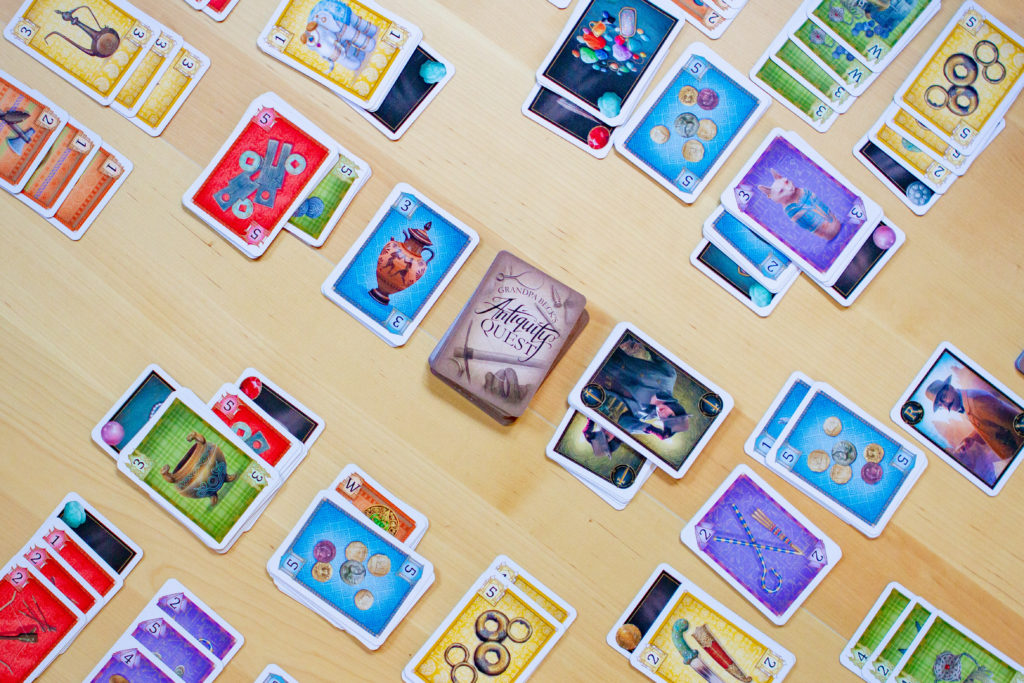
How do you play?
Decide how many rounds you want to play. For a quick game, you can go for one round, for a longer game they suggest 3.
To start a round, shuffle up the cards and deal each player two stacks of ten cards. Select one stack cards to hold in your hand, the other will stay face down on the table. This is your cache. Players may not pick up their cache until they have played all the cards in their hand first.
The rest of the cards are placed in the center of the table and form the draw deck.
There are three types of cards in Antiquity Quest
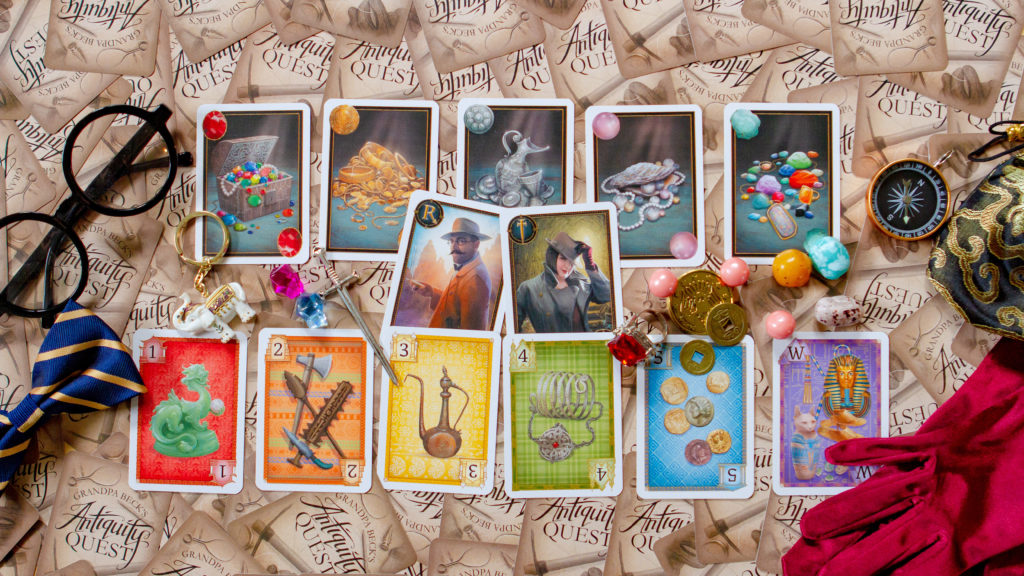
Antiquity Cards: these come in six different colored suits (Red, Orange, Yellow, Green, Blue, Purple) and are numbered 1-5 plus Wilds in each suit.
Treasure Cards: There are five unique Treasure Cards. These can be used to create their own collection of treasure cards or used with antiquity cards to form mixed collections. (more on that below)
Character Cards: There are two types of Character Cards in the game. Nigel Remington and Tess Wynter. Remington allows you to draw three cards during your turn. Tess allows you to remove the contents in the discard pile from play when you discard her. Remington counts towards your score when you play him, put the card off to the side by your completed collections. Both Remington and Tess count against your score if they are in your hand at the end of the round.
You’ll score points from any cards you’ve played from your hand onto the table and any collections you made.
There are three different types of collections you can make, each differing in value.
Perfect Collections: a set of five unique treasure or single suit antiquity cards (no duplicate cards)
Standard Collections: a set of five treasure or single suit antiquity cards. (duplicates cards allowed)
Mixed Collections: sets of five or more treasure and single suit antiquity cards.
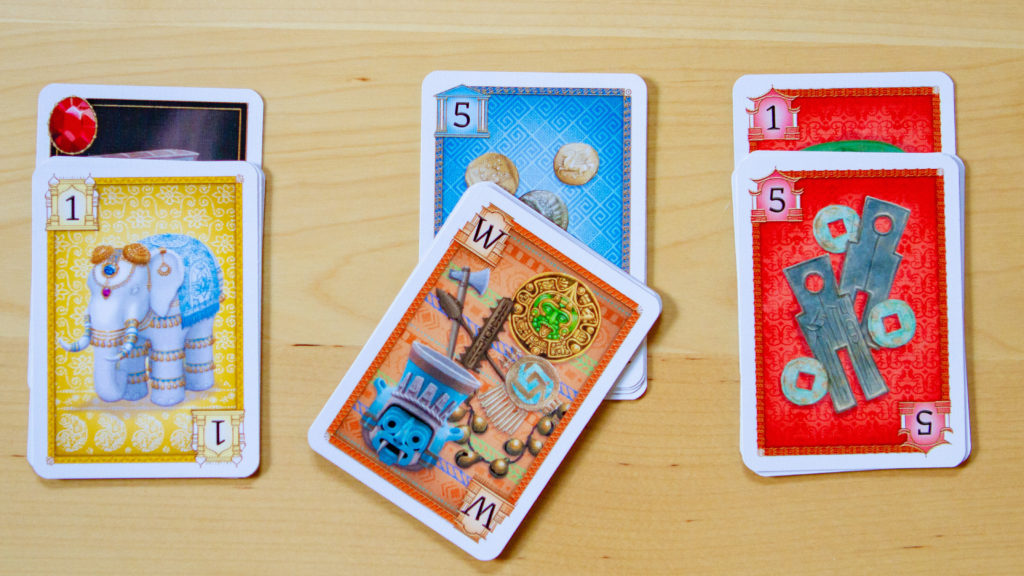
Playing Antiquity Quest:
On your turn, you can do three things in this order:
Draw
Play
Discard
Draw:
You must always draw at the start of your turn.
When drawing, you may either:
a.) Draw two cards from the top of the deck and place them into your hand. Or
B.) Draw the entire discard pile. (You may only do this is you have already started at least one collection, and have at least two cards cards in your hand from the same suit as the top card in the discard pile. You must start a new collection with these cards before adding the rest of the discard pile to your hand.)
Play:
After drawing you may play as many cards from your hand as you would like. You may start a new collection, add to an incomplete collection you played in a turn previously, or add to a mixed collection that you have already completed. (Mixed collections are the only completed collections you may add to.)
Cards are played in sets of three or more to start collections. A completed collection is a set of five cards that are then collapsed and placed off to the side.
You may also play onto other players’ collections! What? No way! Yes way!
On your turn, if you have already started a collection of your own you may play cards from your hand onto their incomplete collections or completed mixed collections. This is a great way to rid cards from your hand to get to your cache and/or lessen the potential point value of your rivals’ collections. (look out though, when you go low… they’ll definitely strike back.)
Discard:
To end your turn, select one card from your hand to discard. Then play passes to the next person.
Going Out/End of Round
On your turn you can go out to end the round if you have at least five completed collections and are playing the last card from your cache.
If you do, you get 500 bonus points while everyone else gets one last turn to try to play as many of their cards as they can so they aren’t saddled with a bunch of points to deduct.
Then the round is over and everyone tallies up their end of round scoring.
You earn points for going out, completed collections, and ALL of the cards you played into both completed and incomplete collections. Cards left unplayed in your hand or in your cache count against your final total.
If you’re only playing one round, then the player with the highest score is the winner.
If you’re playing more than one, shuffle up, deal out, and start the next round!
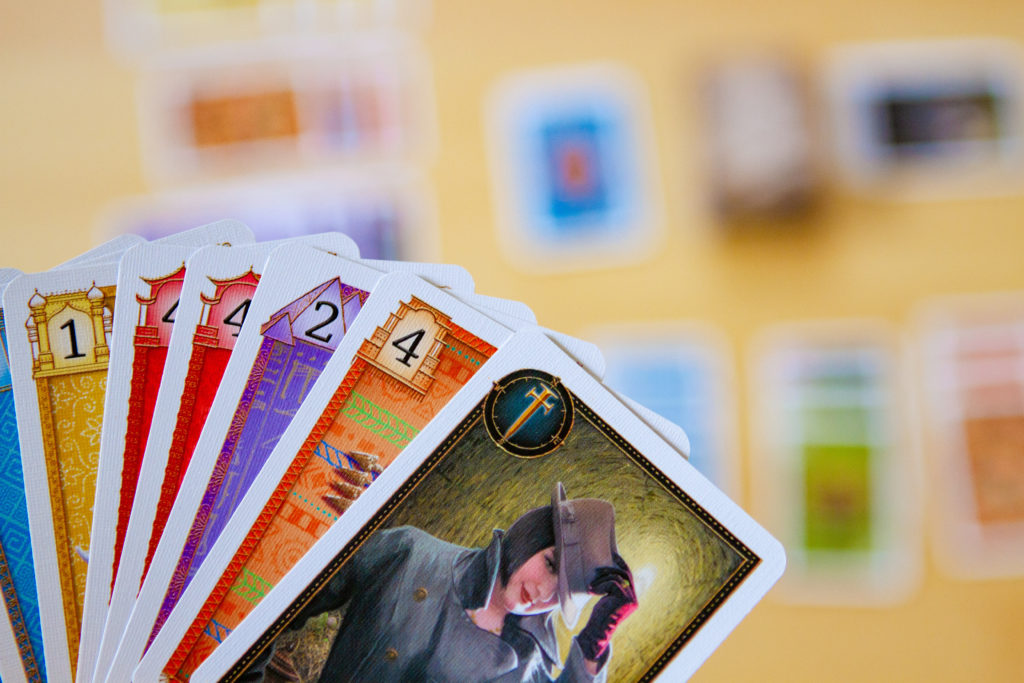
What Did We Think?
Let me first begin my thoughts on Antiquity Quest with this preface:
I have spent over a quarter of a century playing Canasta. Canasta is my family’s game. I’ve grown up watching and playing Canasta since before I could even say the word Canasta. Every year we hold a family Canasta tournament. All of my children will be taught how to play this game. And their children, too. I will most likely spend the rest of my life playing Canasta.
I love Canasta.
So what does that mean? Well, it means I’m a bit biased.
This is both good and bad for Antiquity Quest.
Good because once I heard that Antiquity Quest would be a reimagining of Hand and Foot, itself a spin-off from Canasta, I have been eagerly awaiting its release. I already knew that I would love the experience involved in this style of set collection game.
Bad because Antiquity Quest, more than other games, has a steeper hill to climb as it battles my emotional bond to the game I grew up playing. It’s hard not to compare the two, especially since they are so similar.
So it should come as no surprise to hear that there were things I really liked, and some that I’m not so sure on. Now that you know a little bit about the lens I’m looking through when playing and reviewing Antiquity Quest, lets get to it!
First, here’s what I liked!
The game looks fantastic. The art and design from the box to the cards is so very well done. I greatly enjoy the colors and looking at the beautiful illustrations present on each card and how each suit represents a different civilization. While each card is vibrant and beautifully illustrated, nothing gets in the way of the necessary information for play allowing everything to remain easy to interpret. It is obvious a lot of thought and care went into the design of Antiquity Quest.
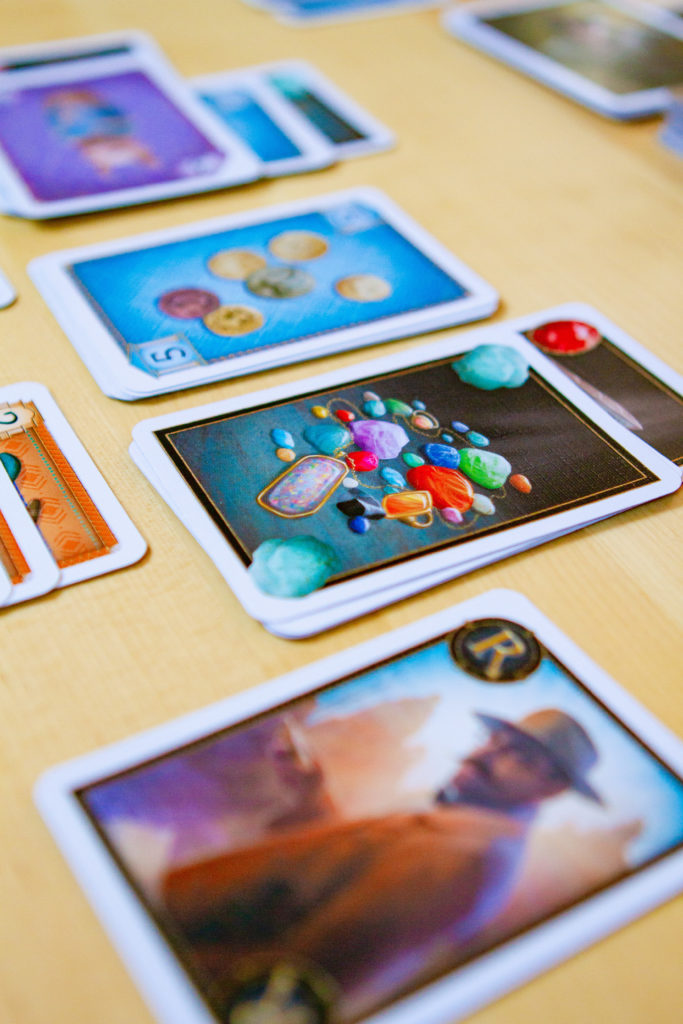
While a theme isn’t necessary for this style of gameplay, treasure hunting fits nicely with a set collection game. Even the cache settles into the theme. You have to hunt around in the deck to find the cards you need to play all the cards in your hand in order to pick it up. Once you do, it’s like finding a bunch of treasures, sometimes it holds just the cards you need to assemble high value collections. What luck!
I really enjoy the ability to play cards from your hand onto your opponents started collections. It’s cold yet satisfying as you make sure that they can’t get that perfect collection. Being able to play cards into completed mixed collections is also nice. This is an easy way to help players that may have a hand that is just not working out, thus allowing them to get rid of cards and hopefully get into their cache or go out.
Now, if you aren’t a big fan of “take that” style of play, you may not enjoy this element. If your started collections keep getting sabotaged by other players before you can complete them in the manner that you’d prefer this could get frustrating fast.
The design of Antiquity Quest also makes it perhaps slightly more accessible for younger kids as opposed to the traditional Canasta/Hand and Foot game. While the box says 10+, I played this with my daughter Alice, age 7, and she picked it up no problem. Only needing to collect five cards to make a collection is a bit easier than needing to wait for 7. I also find that kids gravitate naturally to grouping like with like and colors make this pretty easy. It’s certainly more visually appealing than the original game.
The biggest struggle she had was keeping the types of collections she was making apart. The mixed collection was easy, but standard vs perfect could get a bit confusing. Even some of our adult players had trouble remembering all of the different types they could make. This all should ease with more practice and more games played. Luckily there are some very nice player aids which I highly recommend making sure new players have. Heck, I still use them!
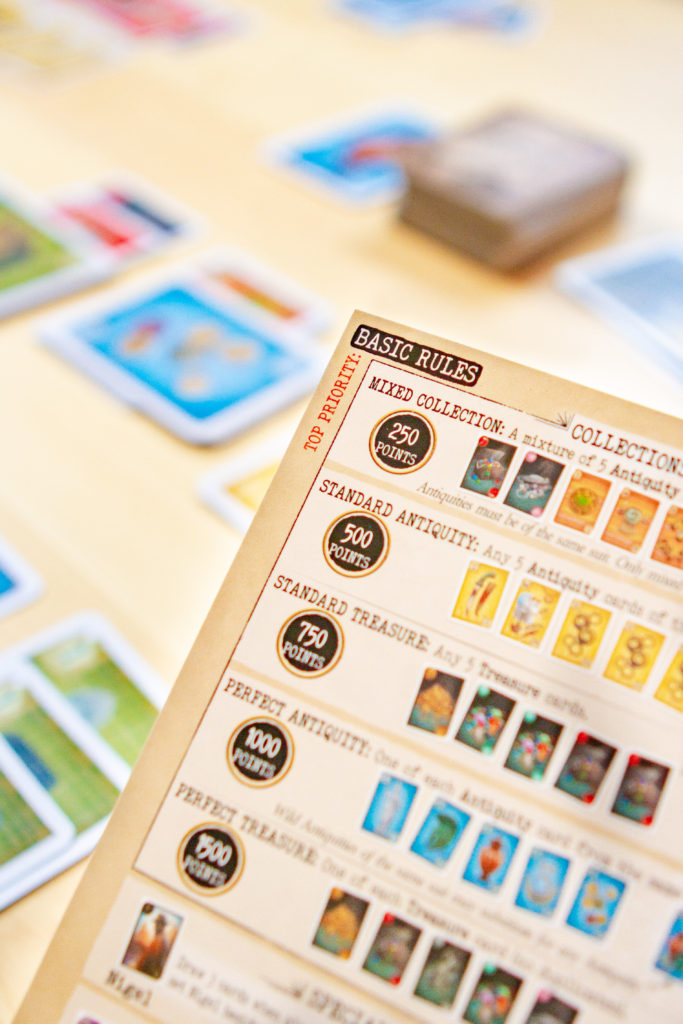
Advanced Play
Another thing I really appreciated about the game was that they included some advanced play variants. While the basic rules work well, after time you can add in a few of these advanced play rules that help extend the shelf life of the game and improve the play experience for the better in some ways. I’ll touch on one of those below.
I really enjoy the civilization bonuses. This gives players bonus points if they are able to collect multiple completed collections in a specific color. This is my favorite advanced play option. I like to add this in as a final round mix-up after playing a couple rounds of basic rules.
The best part of the included advanced play rules is that they are easy to add in if you want to and you don’t have to use them all if you don’t like them.
Customize it to fit your interests and speed!
You said you didn’t like some things??
Even though I really love this game, there were a few things that just weren’t working for me. Nothing too major, though.
In no particular order, here they are:
The going out bonus:
It’s insanely large. 500 points is a lot of points to get just for going out. Unless you are doing a terrible job of it, you almost always win the first round if you go out. It’s such a large bonus that its silly to not rush the game to get it. If you play a decent first hand and snag that bonus, you can play your next round faster, rushing to get the bonus again, and easily maintain the lead as your opponent(s) must now focus on overcoming the point difference from the round(s) before as they are unable to catch you.
This has been replicated in nearly all of our games. We will probably house rule this bonus to be 100 points. Perhaps I’ll change my mind on this, but for now, I think it’s too high.
On the topic of going out, we were not huge fans that players got to play one more time after someone has gone out.
This eliminated just about any tension from the players who have a fat hand of cards because they didn’t have to be worried about getting stuck with them. Even if they hadn’t gotten into their cache yet.
Not having that fear did two things:
- Since I was never worried about getting stuck with 100’s of points in my hand should someone go out, I never made any rash decisions. There was never a point where I was like, “I just can’t hold these any longer! I’ve got to play before you catch me!”
- Perhaps most importantly, this took away the ability for players not in first place to catch the leader by not allowing them to go out in a flash and catch them with a hand full of cards.
That last one is probably the biggest here. As I said, once you get a decent lead in Antiquity Quest, especially in a game with fewer players, the game is yours to lose. There needs to be a way for players to catch the leader off their guard or pressure them to make rash decisions. Here is where a 500 point bonus might be beneficial if you could get that bonus then stick someone with their full hand.
In the advanced play they have rules that kind of addresses this, but players are still able to play the cards that they have in their hand. No, they can’t get into their cache, so that’s good, but they can still play.
I think that these rules are okay if you are playing with kids. Actually I encourage them and think that you should. No kid should have their soul completely crushed because Aunt Kathy went out and now they’re stuck with 1000+ points between their hand and cache. (speaking from a soul crushing experience here.) But if you’re playing with adults, I think the round should just end cold turkey. Some one goes out, round over. Lots of points in your hand? Too bad!
The final thing I wasn’t a fan of were the wild suit cards. I thought they made making the collections a bit too easy. The treasures are supposedly wild cards which can be added to any colored suit. Plus they’re worth more. The wild suit cards are not worth any extra points and only really make it easier to get a perfect collection.
Those perfect collection scores are massive, and it should be hard to get them. Plus, if you had to use a wild to get it, is your collection really perfect?
Would I ever play Antiquity Quest over Canasta?
That answer is easy: YES!
I love that Antiquity Quest allows for more than two or four players to play!
Frequently at family gatherings we’ll have three people want to play, so that means that either we have to find someone else to play pairs, or one person has to sit out. Bummer.
With Antiquity Quest we can play at three and four players easily without the need to play pairs! Even better, we can now play up to 8! This is worth driving home for Thanksgiving just to play one giant game with all of the best card players in the family! (oh my gosh, that’s going to be fun!)
Antiquity Quest allows you to play at those odd player counts that Canasta just simply doesn’t allow for, meaning its going to see some decent table time.
At the two player level, it’s a toss up. Antiquity Quest truly plays very well at two players and the only draw back would be that there are just so many cards. That’s a lot of shuffling work for two players. Start working those hand muscles now!
Speaking of how many cards there are, I highly recommend picking up one of these fancy schmancy card trays! This helps keep everything organized during play and easily passed to the other side of the table if need be. Trust me, you do not want to play 200+ card pick up with this one!
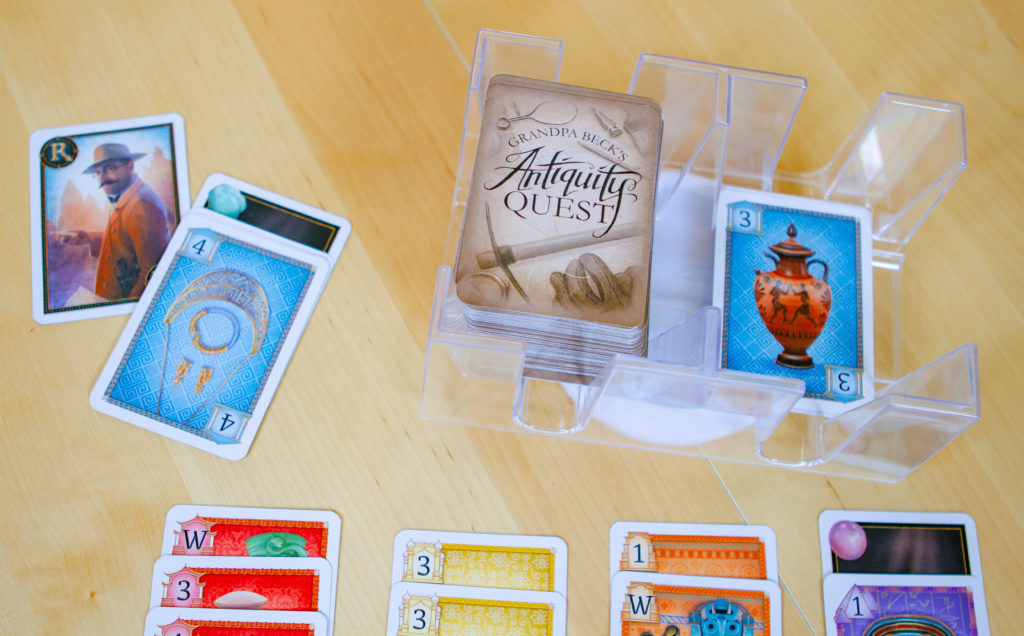
Closing thoughts.
All in all, I think Grandpa Beck’s has another winner on their hands. This is a great game and a wonderful way to introduce people to the classic card joy that is Canasta style gameplay. Its bright art, clever tweaks to the original game, and easy ability to add advanced play rules when you wish make it a fantastic choice for families. As a gamer, I love the strategy that comes into play of knowing when to hold my cards, when to play, and when to toss a card into an opponents collection to sabotage their point value.
Most importantly, I love that this game works for just about any size group you might have. The variations bought about by playing individually or with a partner will also keep the game fresh and exciting as you continue to refine your strategy play after play.
Because of all this, I highly recommend Antiquity Quest!
There’s Also Cookies!
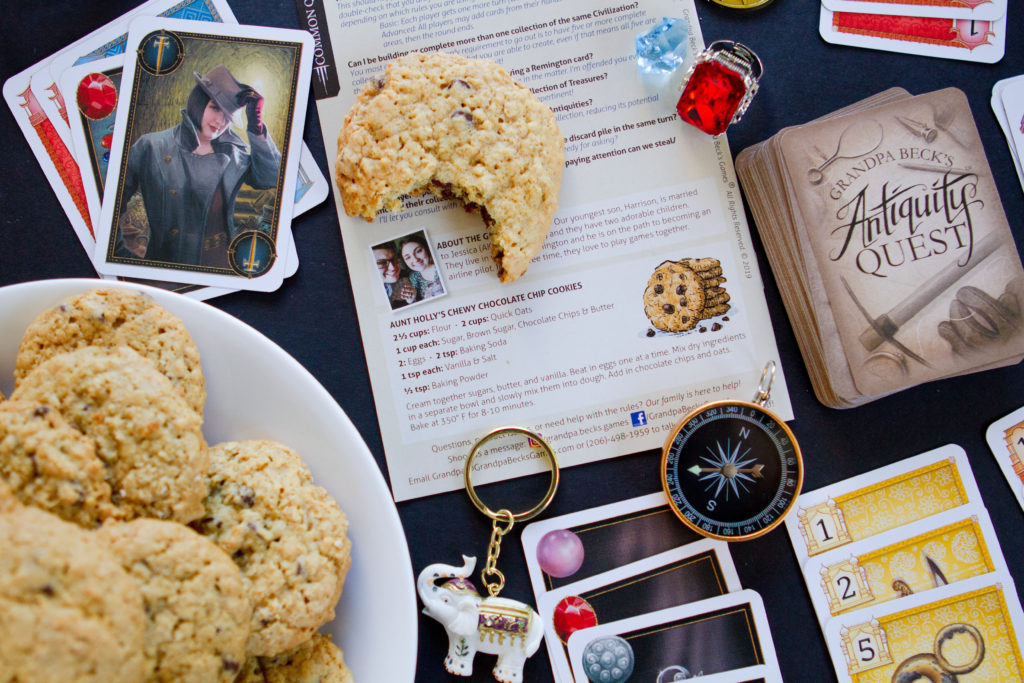
Did you know that inside each and every Grandpa Beck’s Game is a family recipe that they share with you?
It’s easily one of my favorite little extras in any rulebook and you know we had to try out Aunt Holly’s cookie recipe included in Antiquity Quest!
The kids gave it two chocolate-y chip thumbs up!

A special thank you to the great folks at Grandpa Beck’s Games for sending us this copy of Antiquity Quest to review. As always, our thoughts and opinions are our own.
Game Info:
Title: Antiquity Quest
Designers: Harrison Beck and Jessica Beck
Artist: Apryl Stott
Publisher: Grandpa Beck’s Games
Ages 10+ for 2-8 players
Published: 2019
* This post contains affiliate links at no cost to you. To read my full disclosure policy click here.*


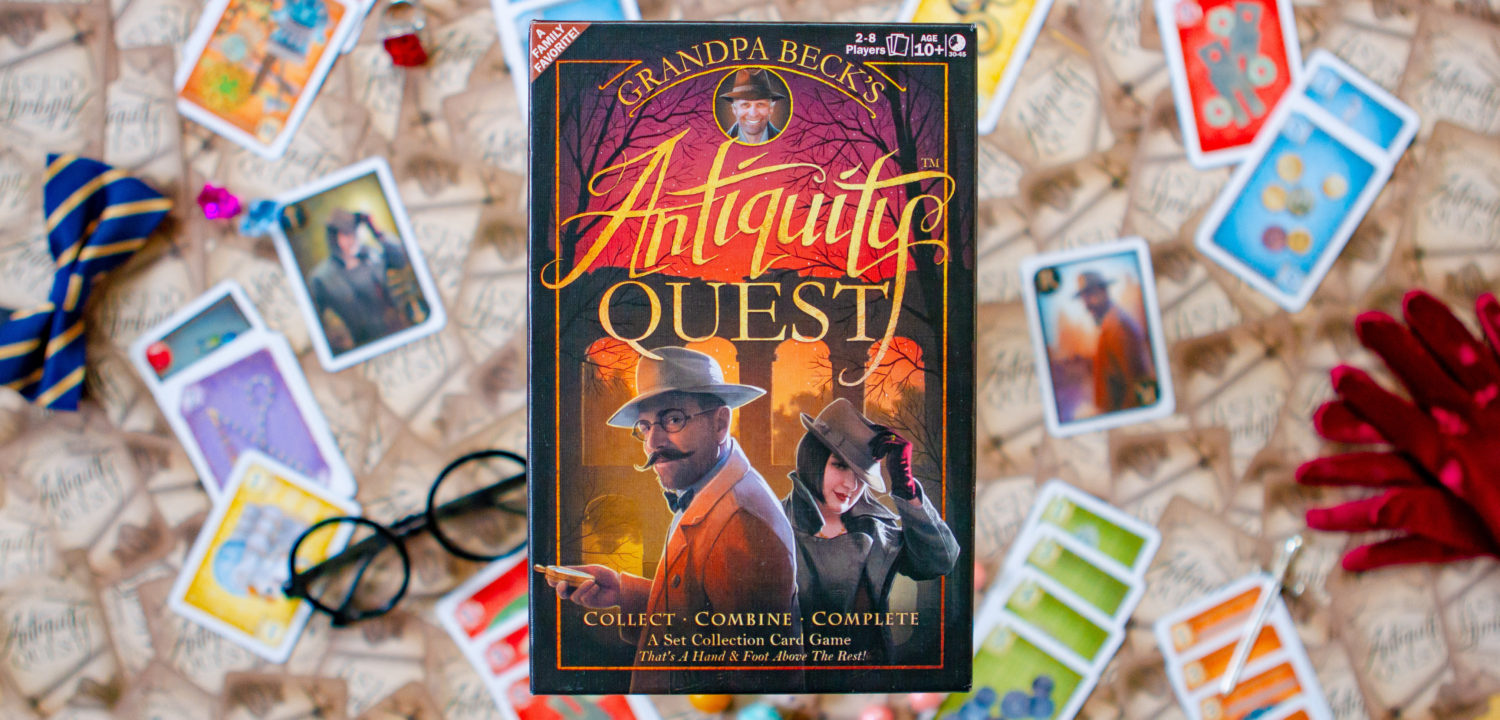

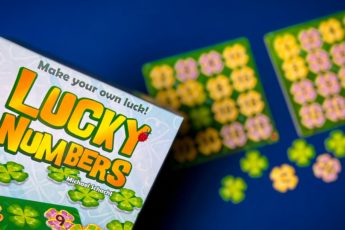







Leave a Comment